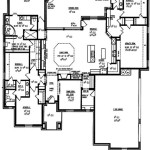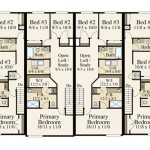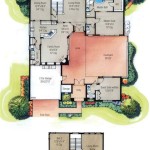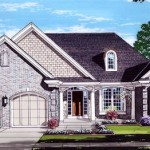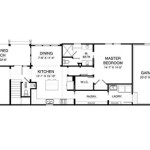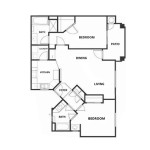Two-Story Contemporary House Plans: Balancing Style and Functionality
Two-story contemporary house plans represent a prevalent architectural trend, offering a fusion of modern aesthetics with the practicality of maximizing living space on a given plot of land. These designs often prioritize clean lines, open floor plans, and the integration of indoor and outdoor spaces. This architectural style caters to a diverse demographic, from young professionals and growing families to empty nesters seeking a stylish and efficient home.
The appeal of contemporary architecture lies in its adaptability. It is not rigidly confined by historical precedents, allowing for innovative use of materials, unconventional layouts, and a focus on energy efficiency. Two-story plans specifically capitalize on vertical space, separating living areas from private bedrooms, providing privacy and a sense of delineation within the home.
Key Features of Contemporary Two-Story Designs
Contemporary architecture is characterized by several defining features that contribute to its distinct appearance and functionality. These features often influence the layout and overall ambiance of two-story house plans.
Open Floor Plans: One of the most recognizable features is the open floor plan concept. This typically involves combining the kitchen, living room, and dining area into one large, flowing space. This design promotes social interaction and creates a sense of spaciousness, even within a smaller footprint. Natural light is often maximized in these open areas, contributing to a bright and airy atmosphere.
Large Windows and Natural Light: Contemporary homes often incorporate large windows, skylights, and glass doors to maximize natural light penetration. This not only reduces the need for artificial lighting during the day but also provides expansive views of the surrounding landscape. The strategic placement of windows can also contribute to passive solar heating and cooling, enhancing energy efficiency.
Clean Lines and Minimalist Aesthetics: Simplicity is a key element of contemporary design. Clean lines, geometric shapes, and a lack of ornamentation are characteristic. Exterior facades often feature flat or low-sloping roofs, smooth surfaces, and minimal detailing. Interior spaces are similarly uncluttered, with a focus on functionality and a minimalist aesthetic.
Integration of Indoor and Outdoor Spaces: Contemporary house plans frequently blur the lines between indoor and outdoor living. Large sliding glass doors, patios, decks, and balconies extend the living space and provide opportunities for outdoor relaxation and entertainment. Landscaping is often incorporated as an integral part of the design, creating a seamless transition between the home and its surroundings.
Sustainable Materials and Energy Efficiency: Contemporary architecture often embraces sustainable building practices and materials. Eco-friendly materials such as recycled wood, bamboo flooring, and low-VOC paints are frequently used. Energy-efficient appliances, insulation, and heating and cooling systems are also incorporated to reduce the home's environmental impact and lower energy bills.
Considerations When Choosing a Two-Story Contemporary House Plan
Selecting the right two-story contemporary house plan requires careful consideration of several factors, including lifestyle, budget, site conditions, and local building codes. A well-thought-out plan will not only meet the homeowner's needs but also maximize the potential of the property.
Lifestyle and Family Needs: The number of bedrooms and bathrooms, the size of the living areas, and the presence of specific features such as a home office, media room, or playroom should be carefully considered based on the family's lifestyle and needs. The layout should also be adaptable to accommodate future changes in the family's composition or lifestyle.
Budget and Construction Costs: The budget is a crucial factor in determining the size, materials, and complexity of the house plan. Construction costs can vary significantly depending on the location, the availability of skilled labor, and the price of materials. It is important to obtain accurate cost estimates from builders before finalizing the plan.
Site Conditions and Orientation: The topography, soil conditions, and orientation of the building site will influence the design and placement of the house. The plan should take advantage of natural sunlight, prevailing winds, and views while minimizing the impact on the environment. Proper drainage and foundation design are also essential to ensure the stability and longevity of the structure.
Local Building Codes and Regulations: All construction projects must comply with local building codes and regulations, which may include restrictions on height, setbacks, lot coverage, and architectural style. It is important to consult with local authorities to ensure that the house plan meets all applicable requirements.
Future Resale Value: While personal preferences should be prioritized, it is also wise to consider the potential resale value of the home. A well-designed and maintained contemporary home in a desirable location is likely to appreciate in value over time.
Examples of Two-Story Contemporary House Plan Variations
The versatility of contemporary architecture allows for a wide range of design variations within the two-story framework. Different architectural elements and material combinations can create distinct styles that cater to diverse tastes.
Modern Farmhouse: This style blends contemporary aesthetics with traditional farmhouse elements. It typically features a simple gabled roof, white siding, and large windows. Interior spaces often incorporate rustic wood accents, shiplap walls, and farmhouse-style fixtures.
Urban Contemporary: Designed for city living, this style emphasizes sleek lines, minimalist aesthetics, and efficient use of space. It often incorporates industrial-inspired elements such as exposed brick, concrete floors, and metal accents. Large windows provide city views and maximize natural light.
Coastal Contemporary: This style is characterized by its light and airy feel, incorporating natural materials and a color palette inspired by the ocean. Large windows and sliding glass doors provide access to outdoor decks and patios. Common features include wood siding, shingle roofs, and coastal-inspired landscaping.
Mid-Century Modern Revival: Drawing inspiration from the mid-20th century, this style features clean lines, simple geometric shapes, and an emphasis on natural materials. Low-sloping roofs, large windows, and open floor plans are characteristic. Interior spaces often incorporate vintage furniture and accessories.
Mountain Contemporary: This style is designed to blend seamlessly with the natural surroundings of mountainous regions. It often features exposed wood beams, stone accents, and large windows that frame panoramic views. Sustainable materials and energy-efficient design principles are typically incorporated.
Advantages of Choosing a Two-Story Design
Opting for a two-story house plan offers several advantages compared to single-story designs, particularly in terms of land usage and privacy.
Maximizing Land Usage: A two-story house plan allows for a larger living space on a smaller plot of land. This is particularly advantageous in urban areas or where land costs are high. By building vertically, homeowners can maximize the use of their property and create more outdoor space for gardens, patios, or recreational activities.
Increased Privacy: Separating living areas from bedrooms on different floors provides increased privacy. This is particularly beneficial for families with children or for those who work from home. The bedrooms on the upper floor are typically quieter and more secluded from the noise and activity of the main living areas.
Enhanced Views: The upper floor of a two-story house often provides enhanced views of the surrounding landscape. This can be a significant advantage if the property is located in a scenic area or offers desirable city views. Large windows and balconies on the upper floor can maximize the enjoyment of these views.
Clearer Zoning: Two-story designs facilitate a more distinct separation of functions within the home. The ground floor can be dedicated to living, dining, and entertaining, while the upper floor provides a sanctuary for rest and relaxation. This zoning can contribute to a more organized and functional living environment.
Potential for Better Ventilation: Two-story homes can naturally benefit from the stack effect, where warm air rises and escapes through upper-level windows, creating a natural ventilation system. This can reduce the reliance on air conditioning and improve indoor air quality. Careful planning of window placement and ventilation systems can optimize this effect.

Two Y Floorplan The Odyssey By National Homes Architectural Design House Plans Modern Floor

2 Story Modern House Plans Houseplans Blog Com

2 Story Modern House Plans Houseplans Blog Com

2 Story Modern House Plans Houseplans Blog Com

Luxury Two Story Contemporary Style House Plan 8501

Plan 666005raf Two Story Contemporary Northwesty Style House Modern Plans Architecture

Exclusive Two Story Contemporary Style House Plan 2370 The Chinool

Two Story Contemporary Style House Plan 9802 The Frederick

Luxury 2 Story Contemporary Style House Plan 7557 Floor Plans Modern Exterior Designs

2 Story Contemporary House Plan Commonwealth Plans Modern Prairie Home Architectural

